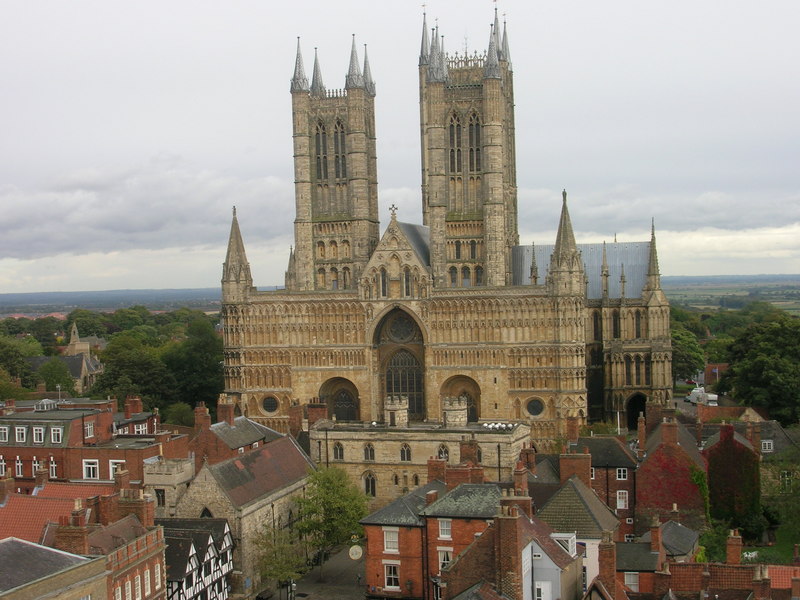|
Bishop Grosseteste University
Bishop Grosseteste University (BGU) is a public university in the city of Lincoln, England. BGU was established as a teacher training college for the Diocese of Lincoln in 1862. It gained taught degree awarding powers in 2012, applied for full university status, and was granted on 3 December 2012. It has around 2,300 full-time students enrolled on a variety of programmes and courses. History Lincoln Diocesan Training School for Mistresses was founded in 1862. It occupied the premises of an earlier, unsuccessful training establishment for female teachers, which had been built in 1842 with a chapel, lecture rooms and a school for teaching practice. It was later renamed Lincoln Diocesan Training College and, to mark the centenary in 1962, was renamed Bishop Grosseteste College. The college took its name from Robert Grosseteste (also known as Robert Greathead and Robert of Lincoln), a 13th-century statesman, scholastic philosopher, theologian, scientist and Bishop of Lincoln. T ... [...More Info...] [...Related Items...] OR: [Wikipedia] [Google] [Baidu] |
Public University
A public university, state university, or public college is a university or college that is State ownership, owned by the state or receives significant funding from a government. Whether a national university is considered public varies from one country (or region) to another, largely depending on the specific education landscape. In contrast a private university is usually owned and operated by a private corporation (not-for-profit or for profit). Both types are often regulated, but to varying degrees, by the government. Africa Algeria In Algeria, public universities are a key part of the education system, and education is considered a right for all citizens. Access to these universities requires passing the Baccalaureate (Bac) exam, with each institution setting its own grade requirements (out of 20) for different majors and programs. Notable public universities include the Algiers 1 University, University of Algiers, Oran 1 University, University of Oran, and Constantin ... [...More Info...] [...Related Items...] OR: [Wikipedia] [Google] [Baidu] |
Hall Of Residence
A dormitory (originated from the Latin word ''dormitorium'', often abbreviated to dorm), also known as a hall of residence, a residence hall (often abbreviated to halls), or a hostel, is a building primarily providing sleeping and residential quarters for large numbers of people such as boarding school, college or university students. In some countries, it can also refer to a room containing several beds accommodating people. Terminology Dormitory is sometimes abbreviated to "dorm". In the UK, the word dormitory means a room (rather than a building) containing several beds accommodating unrelated people. This arrangement exists typically for pupils at boarding schools, travellers and military personnel, but is almost entirely unknown for university students. Student housing is normally referred to as "halls" or "halls of residence", or "colleges" in universities with residential colleges. A building providing sleeping and residential quarters for large numbers of people may als ... [...More Info...] [...Related Items...] OR: [Wikipedia] [Google] [Baidu] |
Society For Lincolnshire History And Archaeology
The Society for Lincolnshire History and Archaeology or SLHA aims to create a greater awareness of the history of Lincolnshire, and works to discover and record its heritage. In its present form, the society came into being in 1974, but it has antecedents dating back to 1844. Activities and branches The society's activities include arranging lectures and other events about Lincolnshire's history and archaeology, and the publication of a journal, a newsletter and books about Lincolnshire. The society has its headquarters at the Jews' Court, Lincoln, Jews' Court in Lincoln, where it has a lecture room, and runs a bookshop for new and secondhand books. It has two branch groups, the Sleaford History Group and the South Holland History Group at Spalding, Lincolnshire, Spalding, and also works with other local groups throughout the historic county of Lincolnshire. Earlier societies The Lincolnshire Topographical Society was established in 1840 under the patronage of Baron Monson, Lord ... [...More Info...] [...Related Items...] OR: [Wikipedia] [Google] [Baidu] |
Anne, Princess Royal
Anne, Princess Royal (Anne Elizabeth Alice Louise; born 15 August 1950) is a member of the British royal family. She is the second child and only daughter of Queen Elizabeth II and Prince Philip, Duke of Edinburgh, and the only sister of King Charles III. Anne was born third in the line of succession to the British throne and is now 18th, and has been, since 1987, Princess Royal, a title held for life. Born at Clarence House, Anne was educated at Benenden School and began undertaking royal duties upon reaching adulthood. She became a respected Equestrianism, equestrian, winning one gold medal in 1971 and two silver medals in 1975 at the European Eventing Championships. In Equestrian at the 1976 Summer Olympics, 1976, she became the first member of the British royal family to compete in the Olympic Games. In 1988, the Princess Royal became a member of the International Olympic Committee (IOC). Anne performs official duties and engagements on behalf of the monarch. She is patro ... [...More Info...] [...Related Items...] OR: [Wikipedia] [Google] [Baidu] |
Arthur Blomfield
Sir Arthur William Blomfield (6 March 182930 October 1899) was an English architect. He became president of the Architectural Association in 1861; a Fellow of the Royal Institute of British Architects in 1867 and vice-president of the RIBA in 1886. He was educated at Trinity College, Cambridge, where he studied Architecture. Background He was the ninth son of Charles James Blomfield, Anglican Bishop of London, who began a programme of new church construction in the capital. Born in Fulham Palace, Arthur Blomfield was educated at Rugby School, Rugby and Trinity College, Cambridge. He was then articled as an architect to Philip Charles Hardwick, and subsequently obtained a large practice on his own account. The young Thomas Hardy joined Blomfield's practice as assistant architect in April 1862, and the writer remained friends with Blomfield. He became president of the Architectural Association in 1861; a Fellow of the Royal Institute of British Architects in 1867 (proposed by Ge ... [...More Info...] [...Related Items...] OR: [Wikipedia] [Google] [Baidu] |
Dormer
A dormer is a roofed structure, often containing a window, that projects vertically beyond the plane of a Roof pitch, pitched roof. A dormer window (also called ''dormer'') is a form of roof window. Dormers are commonly used to increase the usable space in a loft and to create window openings in a roof plane. A dormer is often one of the primary elements of a loft conversion. As a prominent element of many buildings, different types of dormer have evolved to complement different styles of architecture. When the structure appears on the spires of churches and cathedrals, it is usually referred to as a ''lucarne''. History The word ''dormer'' is derived from the Middle French , meaning "sleeping room", as dormer windows often provided light and space to attic-level bedrooms. One of the earliest uses of dormers was in the form of lucarnes, slender dormers which provided ventilation to the spires of English Gothic architecture, English Gothic churches and cathedrals. An early ex ... [...More Info...] [...Related Items...] OR: [Wikipedia] [Google] [Baidu] |
Ashlar
Ashlar () is a cut and dressed rock (geology), stone, worked using a chisel to achieve a specific form, typically rectangular in shape. The term can also refer to a structure built from such stones. Ashlar is the finest stone masonry unit, and is generally rectangular (cuboid). It was described by Vitruvius as ''opus isodomum'' or trapezoidal. Precisely cut "on all faces adjacent to those of other stones", ashlar is capable of requiring only very thin joints between blocks, and the visible face of the stone may be Quarry-faced stone, quarry-faced or feature a variety of treatments: tooled, smoothly polished or rendered with another material for decorative effect. One such decorative treatment consists of small grooves achieved by the application of a metal comb. Generally used only on softer stone ashlar, this decoration is known as "mason's drag". Ashlar is in contrast to rubble masonry, which employs irregularly shaped stones, sometimes minimally worked or selected for simi ... [...More Info...] [...Related Items...] OR: [Wikipedia] [Google] [Baidu] |
Tudor Revival Architecture
Tudor Revival architecture, also known as mock Tudor in the UK, first manifested in domestic architecture in the United Kingdom in the latter half of the 19th century. Based on revival of aspects that were perceived as Tudor architecture, in reality it usually took the style of English vernacular architecture of the Middle Ages that had survived into the Tudor period. The style later became an influence elsewhere, especially the British colonies. For example, in New Zealand, the architect Francis Petre adapted the style for the local climate. In Singapore, then a British colony, architects such as Regent Alfred John Bidwell pioneered what became known as the Black and White House. The earliest examples of the style originate with the works of such eminent architects as Norman Shaw and George Devey, in what at the time was considered Neo-Tudor design. Tudorbethan is a subset of Tudor Revival architecture that eliminated some of the more complex aspects of Jacobethan in fa ... [...More Info...] [...Related Items...] OR: [Wikipedia] [Google] [Baidu] |
Lincoln Castle
Lincoln Castle is a major medieval castle constructed in Lincoln, England, during the late 11th century by William the Conqueror on the site of a pre-existing Roman fortress. The castle is unusual in that it has two mottes. It is one of only two such castles in the country, the other being at Lewes in East Sussex. Lincoln Castle remained in use as a prison and court into modern times and is one of the better preserved castles in England; the Crown Courts continue to this day. It is open to the public most days of the week and possible to walk around the walls from which there are views of the castle complex, cathedral, the city, and surrounding countryside. Displayed within the castle is one of only four surviving exemplars of the 1215 issue of Magna Carta. The castle is now owned by Lincolnshire County Council and is a scheduled monument. History Early history After William the Conqueror defeated Harold Godwinson and the English at the Battle of Hastings on 14 October 1 ... [...More Info...] [...Related Items...] OR: [Wikipedia] [Google] [Baidu] |
Lincoln Cathedral
Lincoln Cathedral, also called Lincoln Minster, and formally the Cathedral Church of the Blessed Virgin Mary of Lincoln, is a Church of England cathedral in Lincoln, England, Lincoln, England. It is the seat of the bishop of Lincoln and is the Mother Church#Cathedral, mother church of the diocese of Lincoln. The cathedral is governed by its Dean of Lincoln, dean and Chapter (religion), chapter, and is a Listed building, grade I listed building. The earliest parts of the current building date to 1072, when bishop Remigius de Fécamp moved his seat from Dorchester on Thames to Lincoln. The building was completed in 1092, but severely damaged in 1185 East Midlands earthquake, an earthquake in 1185. It was rebuilt over the following centuries in different phases of the English Gothic architecture, Gothic style, with significant surviving parts of the cathedral in English Gothic architecture#Early English Gothic, Early English, Decorated Gothic, Decorated and Perpendicular architecture ... [...More Info...] [...Related Items...] OR: [Wikipedia] [Google] [Baidu] |










